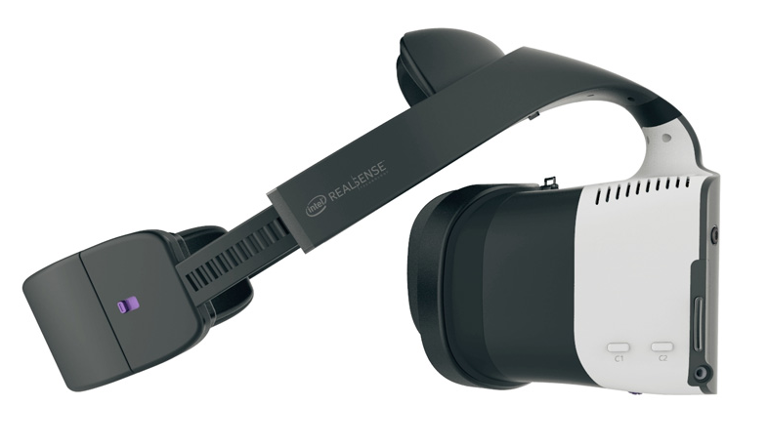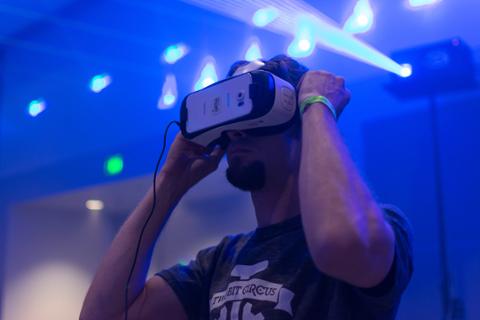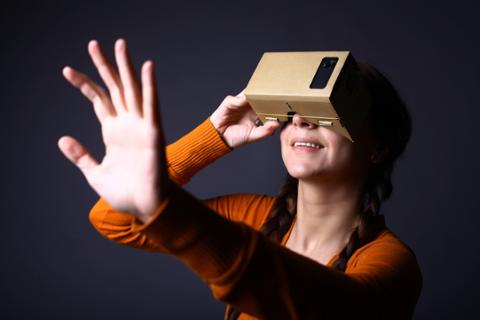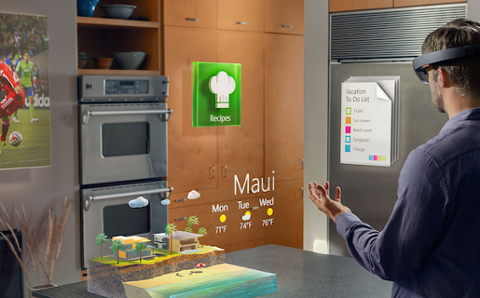 The already-crowded virtual reality (VR) market will soon have a new competitor: Intel. Yes, the chipmaker intends to unleash its own VR platform, currently codenamed “Project Alloy.” As demonstrated this week by Intel CEO Brian Krzanich at the Intel Developer Forum in San Francisco, Project Alloy features a VR headset with no power or peripheral cords (the computer powering it is onboard), along with a set of open APIs for building software. Project Alloy will compete directly against Oculus Rift and the HTC Vive on the higher end of the VR market. (On the cheaper end of the spectrum, Google has made its presence felt with Google Cardboard, which uses a cardboard box and a smartphone screen to simulate virtual environments.) But unlike Oculus Rift and the HTC Vive, which depend on gaming-style handheld controllers, Project Alloy will allow the headset wearer to see and use their hands within the virtual environment. Real-world objects and people will likewise appear when they come within a certain range of the headset’s dual onboard cameras. Intel refers to this insertion of the real world into the virtual one as “merged reality.” In addition to Project Alloy, Intel used its forum to unveil Kaby Lake, the company’s seventh-generation Core processors. These chips will reportedly integrate 4K graphics processors. Anybody want to bet that Intel wants Kaby Lake used in VR-ready PCs? Microsoft executive Terry Myerson also took the stage during Intel’s event to talk about the Windows Holographic shell, which will supposedly arrive for Windows 10 PCs starting in 2017; in theory, even relatively low-powered PCs running the software will have the ability to generate “mixed reality” environments with a combination of virtual and real-world objects (visible through a headset). Intel and Microsoft are also collaborating on a mixed-reality specification for PCs and headsets. If that effort succeeds, it could prompt the two companies’ hardware and software partners to build a variety of AR and VR products. And if that happens, Intel may have found a whole new market that can slow (if not halt) its revenue declines due to imploding PC sales. The chipmaker may have whiffed its attempts to seize the mobile-device market, but it seems determined to make up for that by getting into VR as early as possible. For developers and other tech pros interested in the VR market, it’s worth watching what Intel does over the next year or so. While its headset might not succeed in the fight against Oculus Rift and the HTC Vive, its open APIs and pairing with Microsoft could make it a prominent vendor in the space.
The already-crowded virtual reality (VR) market will soon have a new competitor: Intel. Yes, the chipmaker intends to unleash its own VR platform, currently codenamed “Project Alloy.” As demonstrated this week by Intel CEO Brian Krzanich at the Intel Developer Forum in San Francisco, Project Alloy features a VR headset with no power or peripheral cords (the computer powering it is onboard), along with a set of open APIs for building software. Project Alloy will compete directly against Oculus Rift and the HTC Vive on the higher end of the VR market. (On the cheaper end of the spectrum, Google has made its presence felt with Google Cardboard, which uses a cardboard box and a smartphone screen to simulate virtual environments.) But unlike Oculus Rift and the HTC Vive, which depend on gaming-style handheld controllers, Project Alloy will allow the headset wearer to see and use their hands within the virtual environment. Real-world objects and people will likewise appear when they come within a certain range of the headset’s dual onboard cameras. Intel refers to this insertion of the real world into the virtual one as “merged reality.” In addition to Project Alloy, Intel used its forum to unveil Kaby Lake, the company’s seventh-generation Core processors. These chips will reportedly integrate 4K graphics processors. Anybody want to bet that Intel wants Kaby Lake used in VR-ready PCs? Microsoft executive Terry Myerson also took the stage during Intel’s event to talk about the Windows Holographic shell, which will supposedly arrive for Windows 10 PCs starting in 2017; in theory, even relatively low-powered PCs running the software will have the ability to generate “mixed reality” environments with a combination of virtual and real-world objects (visible through a headset). Intel and Microsoft are also collaborating on a mixed-reality specification for PCs and headsets. If that effort succeeds, it could prompt the two companies’ hardware and software partners to build a variety of AR and VR products. And if that happens, Intel may have found a whole new market that can slow (if not halt) its revenue declines due to imploding PC sales. The chipmaker may have whiffed its attempts to seize the mobile-device market, but it seems determined to make up for that by getting into VR as early as possible. For developers and other tech pros interested in the VR market, it’s worth watching what Intel does over the next year or so. While its headset might not succeed in the fight against Oculus Rift and the HTC Vive, its open APIs and pairing with Microsoft could make it a prominent vendor in the space. Intel Wants a Piece of the Virtual Reality Market
 The already-crowded virtual reality (VR) market will soon have a new competitor: Intel. Yes, the chipmaker intends to unleash its own VR platform, currently codenamed “Project Alloy.” As demonstrated this week by Intel CEO Brian Krzanich at the Intel Developer Forum in San Francisco, Project Alloy features a VR headset with no power or peripheral cords (the computer powering it is onboard), along with a set of open APIs for building software. Project Alloy will compete directly against Oculus Rift and the HTC Vive on the higher end of the VR market. (On the cheaper end of the spectrum, Google has made its presence felt with Google Cardboard, which uses a cardboard box and a smartphone screen to simulate virtual environments.) But unlike Oculus Rift and the HTC Vive, which depend on gaming-style handheld controllers, Project Alloy will allow the headset wearer to see and use their hands within the virtual environment. Real-world objects and people will likewise appear when they come within a certain range of the headset’s dual onboard cameras. Intel refers to this insertion of the real world into the virtual one as “merged reality.” In addition to Project Alloy, Intel used its forum to unveil Kaby Lake, the company’s seventh-generation Core processors. These chips will reportedly integrate 4K graphics processors. Anybody want to bet that Intel wants Kaby Lake used in VR-ready PCs? Microsoft executive Terry Myerson also took the stage during Intel’s event to talk about the Windows Holographic shell, which will supposedly arrive for Windows 10 PCs starting in 2017; in theory, even relatively low-powered PCs running the software will have the ability to generate “mixed reality” environments with a combination of virtual and real-world objects (visible through a headset). Intel and Microsoft are also collaborating on a mixed-reality specification for PCs and headsets. If that effort succeeds, it could prompt the two companies’ hardware and software partners to build a variety of AR and VR products. And if that happens, Intel may have found a whole new market that can slow (if not halt) its revenue declines due to imploding PC sales. The chipmaker may have whiffed its attempts to seize the mobile-device market, but it seems determined to make up for that by getting into VR as early as possible. For developers and other tech pros interested in the VR market, it’s worth watching what Intel does over the next year or so. While its headset might not succeed in the fight against Oculus Rift and the HTC Vive, its open APIs and pairing with Microsoft could make it a prominent vendor in the space.
The already-crowded virtual reality (VR) market will soon have a new competitor: Intel. Yes, the chipmaker intends to unleash its own VR platform, currently codenamed “Project Alloy.” As demonstrated this week by Intel CEO Brian Krzanich at the Intel Developer Forum in San Francisco, Project Alloy features a VR headset with no power or peripheral cords (the computer powering it is onboard), along with a set of open APIs for building software. Project Alloy will compete directly against Oculus Rift and the HTC Vive on the higher end of the VR market. (On the cheaper end of the spectrum, Google has made its presence felt with Google Cardboard, which uses a cardboard box and a smartphone screen to simulate virtual environments.) But unlike Oculus Rift and the HTC Vive, which depend on gaming-style handheld controllers, Project Alloy will allow the headset wearer to see and use their hands within the virtual environment. Real-world objects and people will likewise appear when they come within a certain range of the headset’s dual onboard cameras. Intel refers to this insertion of the real world into the virtual one as “merged reality.” In addition to Project Alloy, Intel used its forum to unveil Kaby Lake, the company’s seventh-generation Core processors. These chips will reportedly integrate 4K graphics processors. Anybody want to bet that Intel wants Kaby Lake used in VR-ready PCs? Microsoft executive Terry Myerson also took the stage during Intel’s event to talk about the Windows Holographic shell, which will supposedly arrive for Windows 10 PCs starting in 2017; in theory, even relatively low-powered PCs running the software will have the ability to generate “mixed reality” environments with a combination of virtual and real-world objects (visible through a headset). Intel and Microsoft are also collaborating on a mixed-reality specification for PCs and headsets. If that effort succeeds, it could prompt the two companies’ hardware and software partners to build a variety of AR and VR products. And if that happens, Intel may have found a whole new market that can slow (if not halt) its revenue declines due to imploding PC sales. The chipmaker may have whiffed its attempts to seize the mobile-device market, but it seems determined to make up for that by getting into VR as early as possible. For developers and other tech pros interested in the VR market, it’s worth watching what Intel does over the next year or so. While its headset might not succeed in the fight against Oculus Rift and the HTC Vive, its open APIs and pairing with Microsoft could make it a prominent vendor in the space. 


